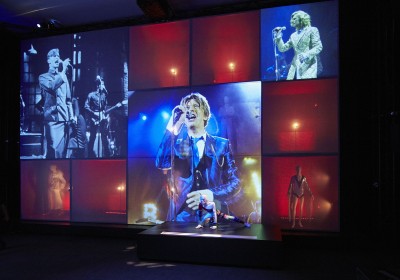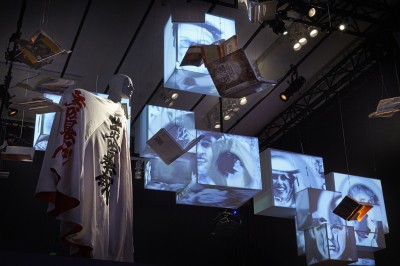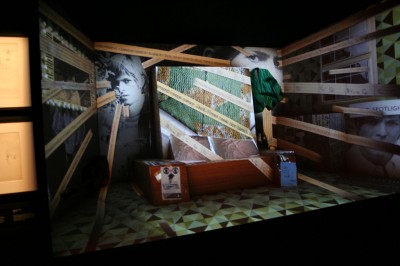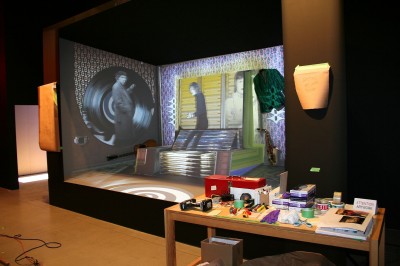
To showcase concert footage, a video wall was assembled using plywood lightboxes with fabric covers. When the lighting changed, visitors could see artifacts inside the boxes.
“It was too big to do everything here,” says Marshall. “We had to assemble and repaint components on-site. I had six installers down there working 12 hours a day, for six days a week, for three weeks.”
The extensive repainting was necessary because almost all display components are flat black, so it was inevitable they would gather dust during fabrication, shipping, handling, positioning and installation.
“You can’t wipe it off,” says Marshall.
Throughout the installation process, as soon as Holman finished its work, another team would come in to add lighting, electronics, audio and other systems to the infrastructure.
Matching projections
The most technically challenging aspect of the exhibition was its heavy use of digitally projected content. The original design team in England sent 20 employees to Toronto to make sure all systems were installed properly, as ceiling-mounted projectors had to throw images with sharp precision onto complex surfaces. One zone, for example, represented Bowie’s childhood bedroom with dynamic images of his various artistic influences appearing on dimensional faces.
“The audiovisual (AV) team had handled the opening ceremonies for the 2012 Summer Olympics in London, so they were very good to work with,” says Marshall.
In another room, an enormous wall showcased concert footage across a series of illuminated ‘steel cages’—actually plywood lightboxes, but using steel back panels—with fabric covers.

Among the biggest fabrication challenges were white ‘boxes’ that hung from the ceiling, with images projected onto their exterior surfaces.
“When you project an image from outside and the light inside is turned off, you can’t see in,” Marshall explains, “and when there’s no projection from outside and the light inside is turned on, you can.”
As the AGO’s floor plan differs from the V&A’s, these lightboxes had to be redesigned, making them lower and wider than the original taller versions. Hence, the digital projections were reconfigured to match.
Finally, another zone featured white ‘boxes’ hanging from the ceiling, with images projected onto their exterior surfaces.
“Those were really difficult to draw, build and install in clusters in very specific ways,” says Marshall. “They were one of the last jobs we tackled.”
Sound all around
One of the integral elements of the touring exhibition is a sound experience designed by Sennheiser, known for manufacturing microphones, headphones and wireless transmission systems.
“For me, Bowie has always been more than a one-dimensional artist,” says Daniel Sennheiser, president of strategy and finance. “He paved the way for self-expression and artistic freedom, so it is only right to celebrate him at the AGO. Our sister company Neumann’s microphones were used on most Bowie albums and I am thrilled we are involved with ‘David Bowie is,’ as a partner and as the provider of the audio guide system and a 3-D sound experience.”

 One zone represented Bowie’s childhood bedroom, with dynamic images of his artistic influences projected onto varying planes. The original design team from England visited Toronto to ensure the images were correctly aligned to the physical structures. Photos by Edgars Apse, Holman Exhibits
One zone represented Bowie’s childhood bedroom, with dynamic images of his artistic influences projected onto varying planes. The original design team from England visited Toronto to ensure the images were correctly aligned to the physical structures. Photos by Edgars Apse, Holman Exhibits
While many museum exhibitions have offered audio guides in the past, ‘David Bowie is’ requires them, as they provide both tour information and all of the exhibition’s soundtracks, which automatically play as a visitor approaches an exhibit, enabling him/her to enjoy an individual experience.
The 3-D sound, meanwhile, is played through hidden speakers in two zones: a collage of Bowie songs arranged by his producer, Tony Visconti, and the aforementioned huge screen installation showcasing concert footage.
“My aim has been to turn stereo sound into immersive surround sound,” says Gregor Zielinsky, Sennheiser’s international recording applications manager. “To achieve this, I developed an algorithm to convert Bowie’s mono and stereo material into multi-channel music. The algorithm uses spatial information to convert the recordings and simulate 3-D sound. I controlled and co-ordinated the conversion. Each song took two days of work in the studio.”
“This is magic to me,” says Visconti. “I don’t know how they do it. Sounds are coming from over my head, down by my feet, over my right shoulder, over my left shoulder, in front of me, to the sides.”
“Sennheiser created a truly immersive experience,” says the AGO’s Teitelbaum.
Fittingly, one of the media partners for the Toronto exhibition was classic rock radio station Q107.
Going on tour
Following its run in Toronto, ‘David Bowie is’ is scheduled to visit the Museum of Image and Sound in Sao Paolo, Brazil, from January 28 to April 21, 2014; the Museum of Contemporary Art in Chicago, Ill., from September 2014 to January 2015; la Philharmonie de Paris/Cité de la Musique in Paris, France, from March to May 2015; and the Groninger Museum in Groningen, The Netherlands, from December 2015 to March 2016.
With files from Holman Exhibits. For more information, visit www.holmanexhibits.com.





